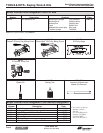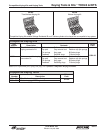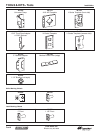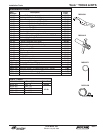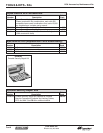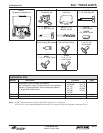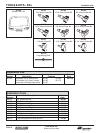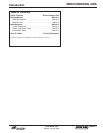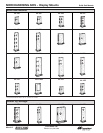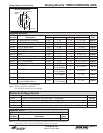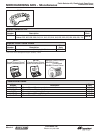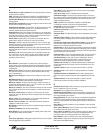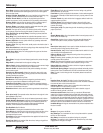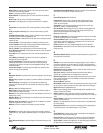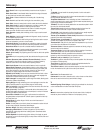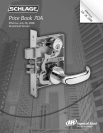
Glossary
Gloss-3
Price Book 70A
Effective July 28, 2008
Kick Plate:
A protective plate applied on the lower rail of the door to
prevent the door from being marred.
Knob:
A projecting handle for operating a lock.
Knob Shank:
The projecting stem of a knob into which the spindle is
fastened.
Knob Top:
That part of the knob that the hand grasps.
Knuckle:
The enlarged part of a hinge into which the pin is inserted.
L
Latch Bolt:
A beveled spring bolt, usually operated by a knob, handle or
turn.
Leaf (of a pair of doors):
One of the two doors forming a pair of
doors.
Letterbox Back Plate:
A plate, similar to a letterbox plate, attached to
the inside of a door to allow the passage of mail.
Letterbox Plate:
A date attached to the door with an opening to permit
insertion of mail.
Lever Handle:
A horizontal handle for operating the bolt(s) of a lock.
Lever Tumbler:
Flat tumbler having a pivoted motion actuated by the
turning of the key and controlling the locking function.
Lip of a Strike:
The projecting part on which the latch bolt rides.
Lock Rail (of the door):
The horizontal member of a door intended to
receive the lock case.
Lock Set:
A lock, complete with trim, such as knobs, escutcheons or
handles.
Lock Stile (of a door):
The stile to which the lock is applied as
distinguished from the hinge stile.
Loose Joint Hinge:
A hinge having but two knuckles; the pin is
fastened permanently to one knuckle, the other contains the pinhole,
whereby the two parts of the hinge can be disengaged by lifting. These
hinges are handed.
Loose Pin Hinge:
A hinge having a removable pin to permit the two
parts of the hinge to be separated.
M
Magnetic Catch:
A cupboard catch that uses a magnet to hold the door
closed.
Master Key:
Operates any quantity of cylinders of different individual key
changes.
Masterkeying
: An arrangement of cylinders having individual key
changes, which permits them all to be operated by a simple key called a
master key.
Mono Lock:
See Preassembled Lock.
Mop Plate:
A narrow plate similar to a kick plate, of sufficient height to
protect against the swish of the mop.
Mortise:
A cavity made to receive a lock or other hardware; also the act of
making such a cavity.
Mortise Bolt:
A door bolt designed to be mortised into a door rather than
applied to its surface.
Mortise Lock (or Latch):
A lock designed to be installed in a mortise
rather than applied to the door's surface.
Mullion:
A fixed or movable post dividing an opening vertically.
N
Nightlatch:
An auxiliary lock having a spring latch bolt and functioning
independently of, and providing additional security to, the regular lock of the
door.
O
Olive Knuckle Hinge:
A paumelle hinge with knuckles forming an oval
shape.
Overhead Concealed Closer:
A closer concealed in the head frame
with an arm connecting with the door at the top rail.
P
Panic Exit Device:
See Exit Device.
Paracentric:
A term used in connection with cylinder plugs having
projections on the sides of the keyway that extend beyond the vertical
center line of the keyway.
Paumelle:
A style of hinge embodying a single pint of the pivot type,
generally of modern, or streamlined design.
Pin Tumblers:
Small sliding pins in a lock cylinder, working against coil
springs and preventing the cylinder plug from rotating until the pins are
raised to the proper alignment by bitting of key.
Pivot:
See Door Pivot.
Plug (of a cylinder):
The round part containing the keyway and rotated
by the key to transmit motion to the bolt(s).
Preassembled Lock:
A lock that has all the parts assembled as a unit
at the factory, and when installed in a rectangular notch cut into the door
edge, requires little or no disassembly.
Prison Lock:
A heavy lock designed especially for use on jail cells.
Push Plate:
A plate applied to the lock stile to protect the door against
soiling and wear
Q
Quadrant (Dutch Door):
A device to fasten together the upper and the
lower leaves of a Dutch door.
R
Rabbet
: A term used to describe the abutting edges of a pair of doors or
windows so shaped as to provide a tight fit. One half of the edge projects
beyond the other half, usually 1/2 . Also used to define that portion of a door
frame into which the door fits.
Rabbeted Lock (or Latch):
A lock in which the face conforms to the
rabbet found on a rabbeted door.
Rail (of a door):
A horizontal member that pins the stiles. May be
exposed as in a paneled door, or concealed as in a flush door
Reinforcing Unit:
A metal box-shaped reinforcement for use in a metal
door in which a bored lock is to be installed. It provides both vertical and
horizontal latch support.
Reverse Bevel:
See Bevel.
Reversible Lock:
A lock which, by reversing the latch bolt, may be used
by any hand. On certain types of locks, other parts must also be changed.
Rigid Lock:
See Preassembled Lock.
Rim:
A term indicating articles of hardware designed for application to the
surface of doors and windows.
Roller Latch:
A friction door latch employing a roller latch head under
spring tension, which engages a strike having a recess formed to receive the
roller.
Roller Strike:
A strike having a rolling member at the point of latch bolt
contact to minimize friction.
Rose:
A trim plate attached to the door under the knob. It sometimes acts
as a knob bearing.
Rounded Front:
A lock or bolt front conforming to the rounded edge of
a double acting door. The standard radius is 4" (101.6 mm).
S
Sash Balance:
A spring device used to counterbalance the weight of a
window sash or other vertical sliding part.
Sash Center:
A pivoted support for transom or sash and comprised of
two parts, one of which contains a pivot, the other a socket for the pivot.
Sash Chain:
A metal chain adapted for use with sliding sash, attached to
the sash and to the counterbalancing sash weight.



